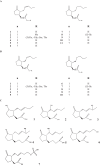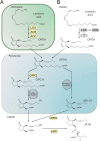Jasmonic acid biosynthesis by fungi: derivatives, first evidence on biochemical pathways and culture conditions for production
- PMID: 33604199
- PMCID: PMC7869668
- DOI: 10.7717/peerj.10873
Jasmonic acid biosynthesis by fungi: derivatives, first evidence on biochemical pathways and culture conditions for production
Abstract
Jasmonic acid (JA) and its derivatives called jasmonates (JAs) are lipid-derived signalling molecules that are produced by plants and certain fungi. Beside this function, JAs have a great variety of applications in flavours and fragrances production. In addition, they may have a high potential in agriculture. JAs protect plants against infections. Although there is much information on the biosynthesis and function of JA concerning plants, knowledge on these aspects is still scarce for fungi. Taking into account the practical importance of JAs, the objective of this review is to summarize knowledge on the occurrence of JAs from fungal culture media, their biosynthetic pathways and the culture conditions for optimal JA production as an alternative source for the production of these valuable metabolites.
Keywords: Culture medium; Fungi; Jasmonic acid; Metabolic pathway; Oxylipin; Submerged fermentation.
© 2021 Eng et al.
Conflict of interest statement
Ivo Feussner is an Academic Editor for PeerJ.
Figures


Similar articles
-
Jasmonates: Emerging Players in Controlling Temperature Stress Tolerance.Front Plant Sci. 2016 Jan 6;6:1129. doi: 10.3389/fpls.2015.01129. eCollection 2015. Front Plant Sci. 2016. PMID: 26779205 Free PMC article. Review.
-
Jasmonic Acid Signaling Pathway in Plants.Int J Mol Sci. 2019 May 20;20(10):2479. doi: 10.3390/ijms20102479. Int J Mol Sci. 2019. PMID: 31137463 Free PMC article. Review.
-
Action of jasmonates in plant stress responses and development--applied aspects.Biotechnol Adv. 2014 Jan-Feb;32(1):31-9. doi: 10.1016/j.biotechadv.2013.09.009. Epub 2013 Oct 2. Biotechnol Adv. 2014. PMID: 24095665 Review.
-
Relative contribution of LOX10, green leaf volatiles and JA to wound-induced local and systemic oxylipin and hormone signature in Zea mays (maize).Phytochemistry. 2020 Jun;174:112334. doi: 10.1016/j.phytochem.2020.112334. Epub 2020 Mar 13. Phytochemistry. 2020. PMID: 32172019
-
Optimized Jasmonic Acid Production by Lasiodiplodia theobromae Reveals Formation of Valuable Plant Secondary Metabolites.PLoS One. 2016 Dec 1;11(12):e0167627. doi: 10.1371/journal.pone.0167627. eCollection 2016. PLoS One. 2016. PMID: 27907207 Free PMC article.
Cited by
-
Adaptation to chronic drought modifies soil microbial community responses to phytohormones.Commun Biol. 2021 May 3;4(1):516. doi: 10.1038/s42003-021-02037-w. Commun Biol. 2021. PMID: 33941844 Free PMC article.
-
Widespread production of plant growth-promoting hormones among marine bacteria and their impacts on the growth of a marine diatom.Microbiome. 2024 Oct 17;12(1):205. doi: 10.1186/s40168-024-01899-6. Microbiome. 2024. PMID: 39420440 Free PMC article.
-
Allies or Enemies? The Power of Plant Hormones in Animals: Insights into Their Regulatory Roles.Molecules. 2025 Jul 16;30(14):2984. doi: 10.3390/molecules30142984. Molecules. 2025. PMID: 40733250 Free PMC article. Review.
-
Pathogens pulling the strings: Effectors manipulating salicylic acid and phenylpropanoid biosynthesis in plants.Mol Plant Pathol. 2021 Nov;22(11):1436-1448. doi: 10.1111/mpp.13123. Epub 2021 Aug 19. Mol Plant Pathol. 2021. PMID: 34414650 Free PMC article. Review.
-
Fungal and bacterial oxylipins are signals for intra- and inter-cellular communication within plant disease.Front Plant Sci. 2022 Sep 16;13:823233. doi: 10.3389/fpls.2022.823233. eCollection 2022. Front Plant Sci. 2022. PMID: 36186042 Free PMC article. Review.
References
-
- Aldridge DC, Galt S, Giles D, Turner WB. Metabolites of Lasiodiplodia theobromae. Journal of the Chemical Society C: Organic. 1971;1971:1623–1627. doi: 10.1039/j39710001623. - DOI
-
- Almeida G, Altuna B, Michelena G. Espoluración en Botryodiplodia theobromae—influencia de la luz en la producción de picnidios. Laboract Acta. 2001;13:89–92.
-
- Almeida G, Klibansky M, Altuna B, Eng F, Legrá S, Armenteros S. Some considerations of the carbon sources used in jasmonic acid production. Revista Iberoamericana de Micología. 1999;16:146–148. - PubMed
-
- Altuna B, Klibansky M, Almeida G, Eng F, Legra S, Armenteros S. Jasmonic acid detection as a new plant growth regulator in strains of Botryodiplodia theobromae. Revista Sobre los Derivados de la Cana de Azucar. 1996;30:16–21.
LinkOut - more resources
Full Text Sources
Other Literature Sources

